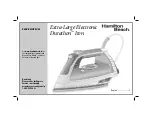
9
Tips for Best Ironing Results
PREPARE TO IRON:
1. Cover your ironing board with a padded, heat-resistant cover. Brush or wipe off any dust, dirt, or debris so it doesn’t end up on your clothes.
2. To set the height of the ironing board, stand with your elbows bent at right angles; then drop your hands slightly so that your arms are in a
comfortable position. Set the height of your ironing board to this height.
3. Check the soleplate (the surface of the iron that meets the fabric) for mineral deposits or scorched material before you begin ironing. If these
deposits or minerals are left on the soleplate, they may end up on your clothes. Unsure? Test-glide the iron on a rag or old towel first.
TEST KITCHEN TIP:
To clean an iron’s soleplate, preheat the iron to the highest temperature setting and iron over a damp, 100% cotton cloth.
This creates heavy steam that transfers grime from the soleplate to the cloth. Many irons have a Self-Clean Button. This will clean the steam
holes, but it will not remove grime from the flat surface of the soleplate.
NOTE: Care should be used while cleaning; steam can burn.
FAST FACTS:
• Don’t iron in a circular motion as this can stretch fabric. Instead, iron lengthwise.
• Natural fibers such as cotton and linen should be ironed slightly damp for faster, easier ironing. If they are completely dry, use maximum
steam while ironing or mist them with water prior to ironing.
• Any portion of a garment that has 2 layers of fabric such as pockets, seams, collars, and cuffs should be ironed inside out first.
• To press a collar, iron from the points in using small strokes of the iron. After wrinkles are pressed out, crease the collar into place by hand—
not with the iron. Treat French cuffs similarly, gently creasing by hand after ironing.
IRONING VERSUS PRESSING:
• You may have heard the terms “ironing” and “pressing” used interchangeably, but they are actually quite different. When ironing, you slide the
iron back and forth over fabric. When pressing, the iron is placed and held on the fabric in one spot, lifted up, and this process is repeated until
the areas that need attention are smooth. A “pressing” technique is helpful to avoid stretching fabrics.
• A pressing cloth can help reduce unwanted “shine” on fabrics. You can purchase a pressing cloth in the laundry care section, or a clean white
dishtowel or 100% cotton pillowcase works equally well. You do not need to increase the recommended iron temperature when using a
pressing cloth.
FABRIC FACTS AND LABELS:
Every fabric is different and should be treated accordingly. The label inside clothing or linens should recommend fabric care instructions that
include ironing treatment. As a general rule, these instructions should be followed. If the fabric is a blend, use a low temperature setting. If you
do not know what the content of the fabric is, use the lowest temperature first and test on an inside seam.































